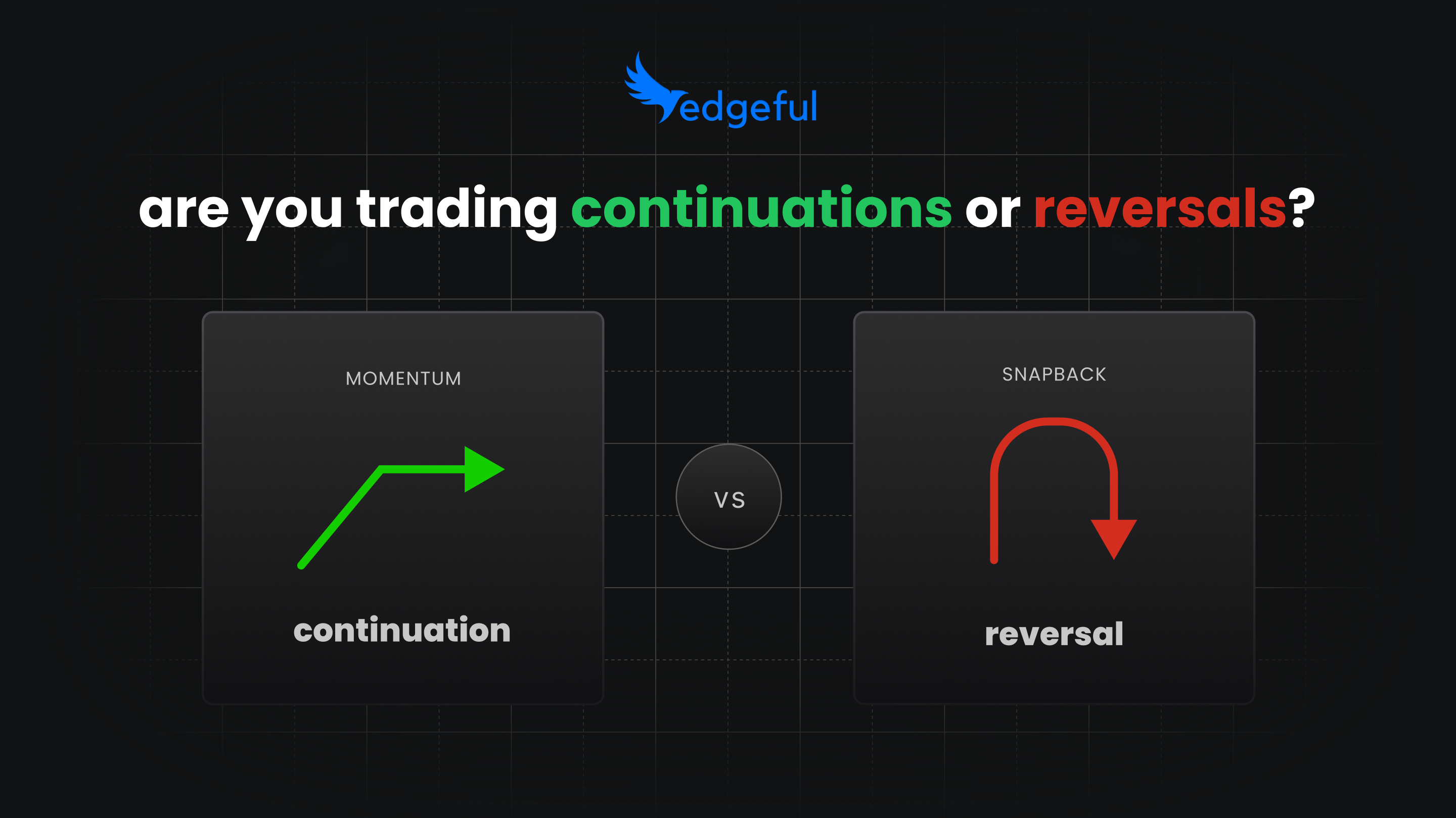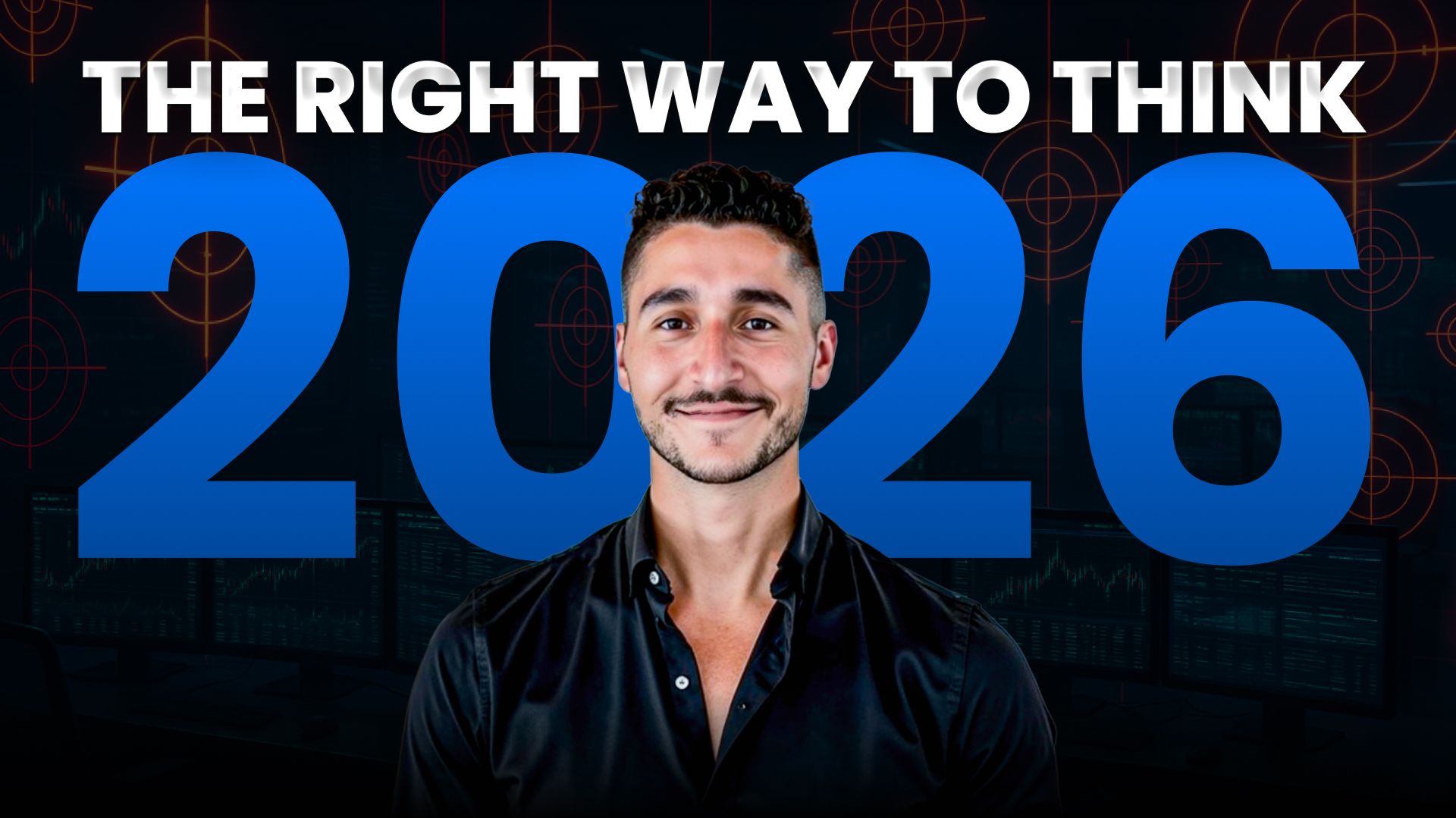swing trading vs day trading: which trading style is right for you?

here's the thing about choosing between swing trading vs day trading — it's highly dependent on your personality. there is no right answer. that's the reality.
I’ve talked with thousands of traders that ask about swing trading vs day trading and if there's a "better" approach, but after years of analyzing data plus working with traders across every style, I can tell you this: the best trading style is the one that matches your schedule, risk tolerance, and psychological makeup.
whether you're drawn to the quick action of day trading or the patience required for swing trading, understanding the fundamental differences will help you make the right choice for your situation. let's break down everything you need to know.
table of contents
- swing trading vs day trading: what’s the difference
- the psychological differences that matter most
- capital requirements: the PDT rule and futures advantage
- time commitment: what your schedule actually allows
- risk management: overnight exposure vs intraday volatility
- profit potential and realistic expectations with swing trading vs day trading
- scalping: the ultra-short-term day trading approach
- futures trading: why it works for both styles
- which trading reports and setups work for each style
- common mistakes traders make when choosing between swing trading vs day trading
- how to know which style fits your personality
- frequently asked questions about swing trading vs day trading
swing trading vs day trading: what’s the difference?
let's start with the basics. day trading means you open a trade and close that trade in the same day. it can be 10 minutes, it can be 3 hours — as long as you open and close the trade in that same day, you're day trading.

swing trading is very different because typically you're going to hold it at least overnight, up until it could be weeks or even months. I wouldn't consider holding for a year swing trading — that's more investing territory.

for swing trading, you believe there's a lot of demand and buying happening in a particular area, you’d want to enter a position — and can do so with multiple entries. you’re looking for price to bounce off this demand zone and go on multi-day or multi-week run.
the key difference between swing trading vs day trading? swing trading is about riding longer moves. it's more trend trading, more continuation trading. in the NVDA example, if you bought calls or shares around $130 looking for continuation higher, you might hold for roughly 90 days or about 3 months to capture that bigger move.
the psychological differences that matter most
this is where most traders get it wrong when choosing between swing trading vs day trading. they focus on the technical differences but ignore the psychological requirements, which are completely different between both!
day trading gives you instant feedback. you know within hours — sometimes minutes — whether your trade is working. this can be incredibly addictive for some people, but it also means constant decision-making throughout the day. you're managing risk, entries, exits, and position sizing in real-time.
the psychological pressure is intense. every tick matters. every news headline during market hours can impact your position. if you're someone who gets stressed by rapid-fire decisions or can't handle the constant mental engagement, day trading will burn you out fast.
swing trading requires a completely different mindset. you need patience — and in some cases, lots of it. you're not getting that instant gratification of quick profits. instead, you're dealing with the psychological challenge of holding positions overnight and sometimes watching them move against you for days before they work out.
many traders underestimate the mental challenge of watching a position fluctuate multiple % points overnight — which is exactly what happens when you swing trade.
like anything in trading, there are real trade-offs. as I’ve written about before in our analysis of why traders lose money, emotional decision-making is one of the biggest account killers.
the psychological requirements are so different that most traders naturally gravitate toward one or the other. very few people are genuinely suited for both approaches.
capital requirements: the PDT rule and futures advantage
here's where things get practical, and it's a major factor that eliminates options for many new traders when considering swing trading vs day trading.
if you want to day trade stocks, you need at least $25,000 in your account due to the pattern day trader (PDT) rule. this rule requires that anyone making more than 3 day trades in a 5-day period maintains a minimum equity of $25,000. for many people starting out, that's a significant barrier to entry.
however, day trading futures is different. you can start with much smaller accounts because futures aren't subject to the PDT rule. this is one reason why many new day traders gravitate toward futures markets — the barrier to entry is much lower.
swing trading stocks doesn't have this restriction. since you're not making multiple buy/sells in a single day, the PDT rule doesn't apply. you can swing trade stocks with any account size, though obviously having more capital gives you more flexibility with position sizing and risk management.
this capital difference is huge. I’ve seen countless traders forced into swing trading simply because they don't have $25,000 to day trade stocks, while others discover futures day trading as their entry point into active trading.
for a deeper dive into how account types affect your trading, check out our complete guide on cash vs margin accounts for day trading.
time commitment: what your schedule actually allows
let's be honest about time requirements when it comes to choosing between swing trading vs day trading.
day trading requires you to be available during market hours. if you're trading U.S. stocks, that's 9:30AM to 4:00PM ET. you don't have to stare at screens all day, but you need to be available to manage positions, adjust stops, and make exit decisions.
if you have a demanding 9-to-5 job, day trading stocks is probably not realistic. I don't care how good you think you are at multitasking — trying to day trade while in meetings or managing other responsibilities is difficult and a recipe for disaster.
and by the way… we’re solving this problem with our algos. read more on them here.
swing trading, on the other hand, can work around a traditional job schedule. you can analyze setups in the evening, place orders before the market opens, and check positions periodically throughout the day. the longer holding periods mean you're not making constant adjustments.
that said, don't think swing trading is "set it and forget it." you still need to monitor news, earnings announcements, and overall market conditions that could affect your positions. but the time commitment is much more flexible.
mobile trading has made both swing trading and day trading more accessible, but there's a difference between checking a swing position on your phone and trying to actively day trade from a mobile device. only you know what you’re capable of.
risk management: overnight exposure vs intraday volatility
let’s talk about the differences between holding overnight and trading intraday volatility with swing trading vs day trading.
as I’ve covered already, day trading means you're not holding anything overnight. you don't have to worry about gap risk — those situations where a stock has unforeseen news hit after hours and it either gaps up when you’re short or gaps down when you’re long — ultimately making it difficult for you to get in/out easily. then, the stock opens significantly higher or lower than where it closed the next day.
with day trading, you're in and out within hours, which means your risk is limited to what happens during market hours.
however, day trading comes with its own risk challenges. the frequent trading means more commissions, more bid-ask spread costs, and more opportunities to make mistakes. the faster pace can lead to overtrading and poor decision-making under pressure.
swing trading involves overnight risk, and this is something many new traders underestimate. here's a perfect example from the NVDA chart we looked at earlier — there was a roughly 12% gap down. if you were long NVDA as a swing trader, that gap would have been painful.

gaps happen. earnings surprises, news events, geopolitical developments — all of these can create significant overnight moves. as a swing trader, you have to accept this risk as part of the game.
that's why position sizing becomes even more critical in swing trading. you can't risk money you can't afford to lose, especially when holding overnight. we've analyzed the psychology of losing streaks in trading, and the data shows that swing traders often face longer drawdown periods than day traders, even if their overall returns might be higher.
profit potential and realistic expectations
let's talk about what you can realistically expect with swing trading vs day trading, because this is where a lot of fantasy trading meets reality.
day trading typically involves smaller individual profits but more frequent opportunities. you might make $50-200 per trade, but you could have multiple trades per day. the key is consistency and reducing the amount of times you let emotions control your trading, rather than data.
swing trading can capture much larger individual moves. in our NVDA example from the first swing trading chart, you would have been up $20-30 per share on that swing trade — something that would never happen on an intraday move. however, these opportunities come less frequently.
here's the thing most people don't consider:
the realistic profit potential depends heavily on your account size, risk tolerance, and skill level. neither approach is a "get rich quick" scheme, despite what social media might suggest.
scalping: the ultra-short-term day trading approach
scalping deserves its own mention because it's essentially day trading, taken to the next level. scalpers hold positions for seconds to minutes, looking to capture very small price movements multiple times throughout the day.
scalping requires intense focus, extremely fast execution, and the ability to make rapid-fire decisions without hesitation. you're looking for tiny moves — maybe 1 to 5 points per trade — but you may take 10+ trades per day.
this approach works well for traders who thrive under pressure and have excellent discipline. however, it's also the most psychologically demanding style of trading. the constant action can be addictive, and the rapid pace makes it easy to overtrade or revenge trade after losses.
most importantly, scalping requires significant capital to make meaningful profits. when you're making $15 per trade, you need size to generate substantial income, which brings us back to the capital requirements we discussed earlier.
now that we've covered scalping, let's explore how futures trading benefits both swing trading vs day trading approaches.
swing trading vs day trading: why futures trading works for both
futures trading has become increasingly popular for both day traders and swing traders, and for good reason. the advantages work regardless of which timeframe you prefer.
first, futures markets trade nearly 24 hours, which gives both day traders and swing traders more opportunities. if you're a day trader who can't trade during regular U.S. market hours, you can trade futures during evening or early morning sessions. swing traders benefit from the ability to exit positions outside regular hours if needed.
the capital requirements are much more accessible. while you need $25,000 to day trade stocks, you can day trade futures with much smaller accounts. this levels the playing field for newer traders who want to try day trading but don't have large amounts of capital.
leverage in futures is also more straightforward and often more favorable than stock margin requirements. this benefits both day traders looking for more buying power and swing traders who want to control larger positions with less capital.
from a practical standpoint, futures eliminate some of the complexity around pattern day trader rules and provide more consistent margin requirements. whether you're day trading or swing trading, the rules and requirements remain the same.
at edgeful, we focus heavily on futures because of these advantages. our data and reports work equally well for day traders and swing traders in futures markets, giving you flexibility to choose your style without changing your analytical tools.
which trading reports and setups work for swing trading vs day trading
different trading styles require different analytical approaches and setups. understanding which tools and reports work best for your chosen style can make a significant difference in your success.
for day trading, you need setups that work on shorter timeframes and provide quick, actionable signals. at edgeful, our most popular day trading reports focus on:
- initial balance (IB) breakouts: these occur within the first hour of trading and often lead to continuation moves throughout the day
- opening range breakouts (ORB): similar concept but focusing on the first 30 minutes of trading
- gap fill strategies: when stocks or futures gap up or down at the open, they often fill those gaps during the trading session
these setups work because they capitalize on early market momentum and typically resolve within a few hours. for additional technical analysis tools that complement these strategies, check out our guide to top tradingview indicators for futures trading.
swing trading requires a different approach focused on longer-term momentum and trend continuation. one of our most effective swing trading strategies is the green and red streak analysis, which identifies when markets are likely to continue or reverse after periods of consistent directional movement.
swing traders also benefit from:
- weekly and monthly support/resistance levels
- earnings and event-driven strategies
- sector rotation and relative strength analysis
- longer-term momentum indicators
the beauty of our approach at edgeful is that we can build custom reports for any trading style. if you're a swing trader and don't see exactly what you need in our existing reports, we can create specific analyses that match your timeframe and strategy preferences.
common mistakes traders make when choosing between swing trading vs day trading
I’ve seen thousands of traders make the same mistakes when choosing between swing trading vs day trading. avoiding these errors can save you time, money, and frustration.
mistake #1: trying to day trade stocks without enough capital
this is huge. too many people try to day trade with $5,000 or $10,000 accounts, hit the PDT rule restrictions, and then get frustrated with trading altogether. if you don't have $25,000 for stock day trading, either focus on futures day trading or consider swing trading until you build your account.
mistake #2: attempting day trading with a demanding full-time job
I get it — day trading looks exciting and profitable. but if you're in back-to-back meetings all day or have a job that requires constant attention, you're setting yourself up to fail. swing trading is a much more realistic option for people with traditional careers.
mistake #3: swing trading with money you can't afford to lose overnight
this ties back to the risk management discussion. if you're swing trading with rent money or funds you need for emergencies, the overnight risk will destroy your decision-making ability. you'll panic-exit good trades and hold bad trades too long.
mistake #4: jumping between styles too quickly
many traders try day trading for a few weeks, lose money, then immediately switch to swing trading. then they lose money swing trading and switch back. give each approach at least 2-3 months of consistent execution before deciding it's not for you.
mistake #5: not matching style to personality
this might be the biggest one. if you're naturally impatient and need instant feedback, swing trading will drive you crazy. if you get stressed by rapid decision-making, day trading will burn you out. be honest about your personality and choose accordingly.
understanding the mistakes helps, but how do you actually decide between swing trading vs day trading
how to know which style fits your personality
after working with thousands of traders, I’ve identified some key personality traits that tend to predict success in swing trading vs day trading. here's how to honestly assess which approach might work better for you.
you might be suited for day trading if:
- you enjoy fast-paced, high-stimulation environments
- you can make quick decisions without second-guessing yourself
- you have the flexibility to be available during market hours
- you prefer getting immediate feedback on your decisions
- you can handle multiple small losses without letting them affect subsequent trades
- you have at least $25,000 for stock day trading or are willing to trade futures
you might be suited for swing trading if:
- you prefer a more methodical, research-based approach
- you can be patient and let trades develop over time
- you have a full-time job or other commitments during market hours
- you don't mind holding positions overnight
- you can handle larger unrealized profits and losses without panicking
- you enjoy analyzing longer-term trends and fundamental factors
questions to ask yourself:
- how do you handle stress and pressure?
- do you prefer instant gratification or can you wait for larger rewards?
- how much time can you realistically dedicate to active trading?
- what's your risk tolerance for overnight positions?
- how much capital do you have available for trading?
remember, there's no wrong choice here. both approaches can be profitable when executed properly and matched to the right personality. the key is being honest about your situation and choosing the style that you can stick with consistently.
frequently asked questions
what is swing trading vs day trading?
day trading involves opening and closing positions within the same trading day, typically holding positions for minutes to hours. swing trading involves holding positions overnight to several weeks or months, capturing larger price movements over longer timeframes.
is swing trading better than day trading?
neither approach is better or worse than the other — it depends on your personality, available capital, time commitment, and risk tolerance. day trading offers more frequent opportunities with smaller individual profits, while swing trading offers less frequent opportunities with potentially larger individual profits.
can you day trade and swing trade at the same time?
yes, many traders use both approaches simultaneously with different portions of their capital. however, this requires excellent organization and risk management to avoid overexposure to the market. most traders find it more effective to master one approach before attempting both.
which requires more capital: swing trading vs day trading?
it depends on the goal — but up front, swing trading requires less capital than day trading (unless you’re focused on futures trading). the $25,000 PDT rule only applies to day trading stocks. swing trading stocks can be done with any account size. however, having more capital provides better position sizing flexibility and risk management options.
swing trading vs day trading: which is more profitable?
profitability depends on skill, consistency, and proper risk management rather than the trading style itself. day trading can generate more frequent income but requires more time and attention. swing trading can capture larger moves but with less frequency. both can be profitable when executed properly.
what's better for beginners: swing trading vs day trading?
swing trading is often better for beginners because it allows more time for analysis and decision-making, requires less capital (avoiding PDT rules), and can be done around a regular job. However, some beginners prefer the immediate feedback of day trading. The key is choosing the style that matches your situation and personality.
key takeaways

- there is no universally "better" trading style - success depends on matching the approach to your personality, schedule, and capital situation
- capital requirements differ significantly - stock day trading requires $25,000 minimum, while swing trading and futures day trading have lower barriers to entry
- psychological demands are completely different - day trading requires quick decision-making and stress tolerance, while swing trading demands patience and comfort with overnight risk
- time commitments vary greatly - day trading needs availability during market hours, while swing trading can work around traditional jobs
- both styles can be profitable when executed with proper risk management, appropriate capital, and consistent methodology
- futures trading offers advantages for both approaches - lower capital requirements, nearly 24-hour markets, and straightforward margin rules
- choose either swing trading vs day trading based on honest self-assessment - consider your personality, available time, risk tolerance, and capital before committing to either approach
the most important thing? pick one approach and stick with it long enough to properly evaluate whether it works for you. jumping between swing trading vs day trading every few weeks is a recipe for inconsistent results and frustration.
whether you choose swing trading vs day trading, having access to quality data and analysis makes a significant difference in your results. at edgeful, we provide reports and strategies that work for both approaches, helping you make informed decisions regardless of your chosen timeframe.

ready to start building consistent trading systems with actionable reports, setups, and statistics? join thousands of traders who use edgeful's data-driven approach to improve their trading results.
whether you're researching swing trading vs day trading or ready to start trading, edgeful provides the data you need.


